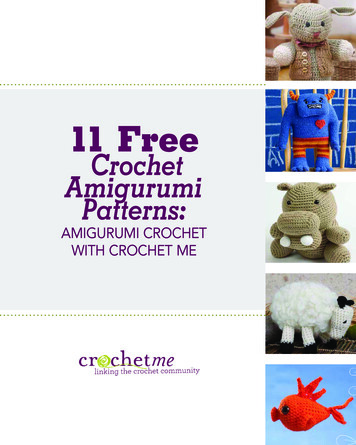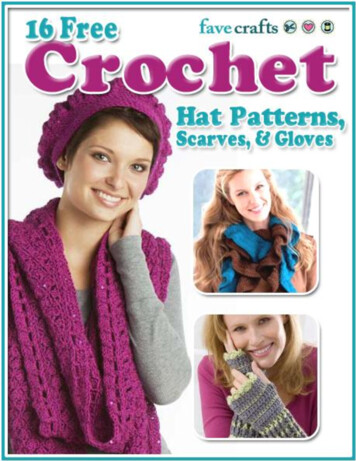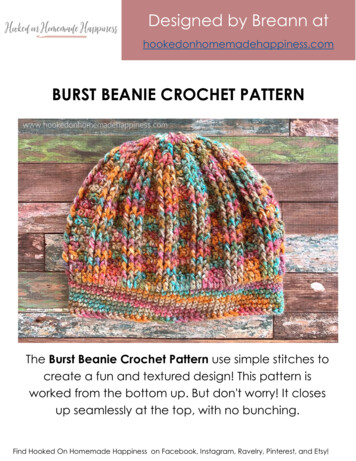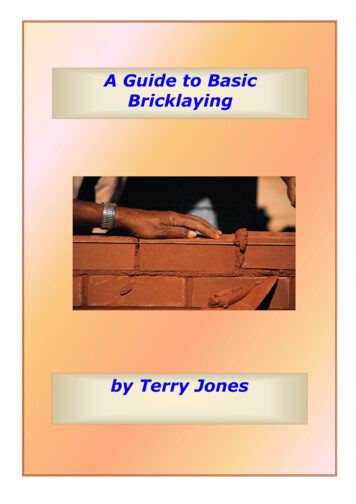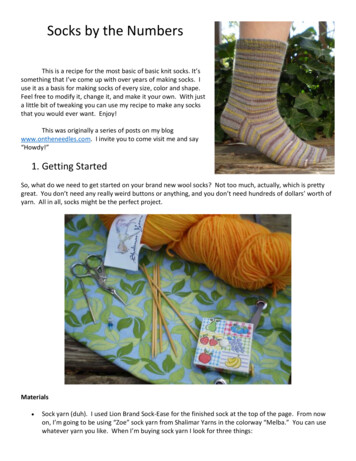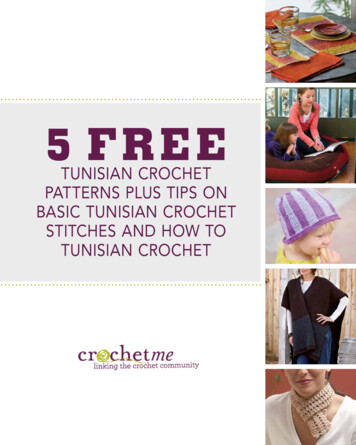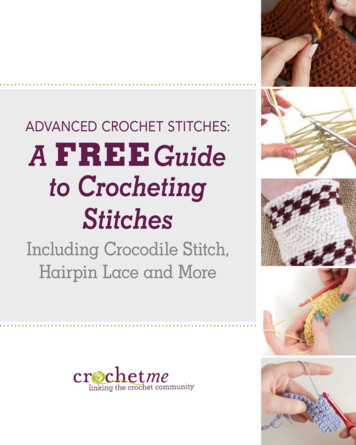
Transcription
ADVANCED CROCHET STITCHES:A FREE Guideto CrochetingStitchesIncluding Crocodile Stitch,Hairpin Lace and More
ADVANCED CROCHET STITCHES:A FREE Guide to Crocheting StitchesIncluding Crocodile Stitch, Hairpin Lace and MoreYOU’VE MASTERED SINGLE CROCHET, DOUBLE CROCHET,AND BASIC INCREASES AND DECREASES. There is somuch more to explore. In this free eBook you will learn how touse the crochet loop stitch to create post stitches to create a funtextured fabric, how to quickly create a solid fabric with linkedcrochet stitches, how to embellish your crochet project withslip-stitch embroidery, and so much more.Crochet the perfect rug, accessory, or amigurumi with theLoop Stitch. This advanced crochet stitch is similar to thesingle crochet but creates a fabric with unworked loops of yarnthat create a textured fabric that is ideal for mimicking fur orhair or constructing a plush fabric perfect for home decor andaccessories.We have all been faced with the same dilemma. Singlecrochet creates a solid fabric, perfect for warm garments andaccessories, but it can take longer to finish the project. Doubleand triple crochet quickly work up into lengths of crochetfabric, but the tall stitches create a fabric with possible spaces.Linked Crochet allows you to use double crochet, triplecrochet, or taller stitches while maintaining a solid fabric.Created by utilizing multiple yarn overs, the Bullion Stitch willadd texture and visual interest to any crochet pattern. In thisshort article, you will learn not only how to work crochetedbullion stitches but tricks for easily pulling your hook throughall of the loops.The Solomon’s Knot, also called the Lover’s Knot, is a beautifulcrochet lace stitch that is perfect for summer garments andaccessories. Step-by-step illustrations will walk you throughcreating this delicate crochet lace knot.Even a simple single crochet piece can become extraordinarywith the addition of Slip-Stitch Embroidery embellishment.Surface crochet can be used to add a touch of color ordimension.Learn 5 Tips for Working Wire Crochet. Crocheting with wirecreates an ethereal piece from the simplest crochet stitches.While you can work any crochet stitch with wire, there are afew tricks of the trade for making crocheting with wire easier.Learn to Create Crocodile Stitches with this article. Thisversion of the crocodile stitch creates rows of “scales.” Usethis technique to form a textured project or a funky accessory.Created with a crochet hook and special loom, hairpin lacecan be used to create amazing garments and accessories.Learn the Basics of Hairpin Lace and Learn to Join HairpinLace with two how-to articles. Each article includes step-bystep photographs as well as written instructions.The historical tradition of using slip stitches to create adense elastic fabric. Sometimes called Bosnian Crochet, thiscrochet technique is frequently used for mittens, hats, andother accessories. Bosnian crochet is currently experiencinga renewed popularity, but there is still plenty of possibilitiesto explore. Experiment with Bosnian crochet with theGobelinstitch Cuffs.Download Advanced Crochet Stitches: A Free Guide toCrocheting Stitches Including Crocodile Stitch, HairpinLace and More and start expanding your advanced crochetstitches repertoire. We would love to see your work; shareyour pictures in the Crochet Me Member Gallery.Best wishes,Editor, CrochetMe.comThe Loop Stitch . . . . . . . . . . . . . . . . . . . . . . . . . . . page 31 2 Linked Crochet . . . . . . . . . . . . . . . . . . . . . . . . . . . . page 43 The Bullion Stitch . . . . . . . . . . . . . . . . . . . . . . . . . page 54 Solomon’s Knot . . . . . . . . . . . . . . . . . . . . . . . . . . . . page 6Slip-Stitch Embroidery . . . . . . . . . . . . . . . . . . . . . page 75 6 5 Tips for Working Wire Crochet . . . . . . . . . . . . . page 87 Create Crocodile Stitches . . . . . . . . . . . . . . . . . . page 98 Learn the Basics of Hairpin Lace . . . . . . . . . . . page 109 Learn to Join Hairpin Lace . . . . . . . . . . . . . . . . . page 1210 Bosnian Lace . . . . . . . . . . . . . . . . . . . . . . . . . . . . . page 1411 Gobelinstitch Cuffs . . . . . . . . . . . . . . . . . . . . . . . page 15 Glossary .Contents . . . . . . . . . . . . . . . . . . . . . . . . . . . . . . . . . . . . . page 16ADVANCED CROCHET STITCHES: A FREEGUIDE TO CROCHETING STITCHES INCLUDINGCROCODILE STITCH, HAIRPIN LACE AND MOREA CROCHET ME E-BOOK EDITED BYToni RexroatE D I T O R I A L S TA F FEDITOR CROCHET METoni RexroatCREATIVE SERVICESJanice TapiaAs noted Gayle FordPRODUCTION DESIGNERPHOTOGRAPHYILLUSTRATIONF W Media, Inc. All rights reserved. F W Media grants permission for any or all pages in this issue to be copied for personal use. ADVANCED CROCHET STITCHES: A FREE GUIDE TO CROCHETING STITCHES INCLUDING CROCODILE STITCH, HAIRPIN LACE AND MORE2
The Loop StitchWorking the crochet loop stitch is very similar tocrocheting the basic single crochet stitch. But thisadvanced crochet stitch creates a loop of unworked yarnon the WS of the piece or the side farthest from you asyou are working the stitch.This stitch technique is ideal for creating fur on amigurumi,hair on dolls, fringe, or a textured shag fabric that isperfect for rugs, scarves, and other accessories.The loop stitch requires only your crochet hook, yarn, andan easily created tool to create even loops. One of theeasiest ways to control the size of your loops is to use apiece of cardboard cut to the desired size of the loops. Ifyou are creating 1” loops, cut a piece of cardboard thatis 1” wide and long enough to work several stitch overthe piece, perhaps 4-6” long. You can also use a ruler ora dowel. Some patterns will tell you to use your fingers tohold the loop at the appropriate length. This takes a littlebit more practice but is a handy skill if you do not have atool nearby.Let’s look at how to work the crochet loop stitch.Row 3: Single crochet across. Theloop stitch is generally worked onlyon one side, though you can workit on both even and odd rows if youwant loops on both sides of yourproject.Repeat Rows 2-3 until your piecereaches the desired length.Figure 2Figure 2Row 1: Work the desired numberof chains and work a row of singlecrochet stitches across yourfoundation chain (fig 1). You canwork foundation single crochetstitches in place of the foundationchain and first row of single crochetstitches.Row 2: *Insert your hook in thenext stitch, hold the cardboardor other loop tool as discussedabove in back of the piece, wrapthe yarn around the tool andbring the end back toward you,yarn over and pull up a loop, yarnover and draw through the twoloops on your hook to completethe single crochet (fig 2); repeatfrom * across. Slip the cardboard,ruler, dowel, or other tool acrossyour piece as you work, removingit from the last stitches when youreach the end of the row.The crochet loop stitch creates anintriguing textured fabric that isperfect for shag carpets, amigurumicreations, or fabulous accessories. Trythis simple crochet stitch today.ADVANCED CROCHET STITCHES: A FREE GUIDE TO CROCHETING STITCHES INCLUDING CROCODILE STITCH, HAIRPIN LACE AND MORE F W Media, Inc. All rights reserved F W Media grants permission for any or all pages in this issue to be copied for personal use. www.crochetme.com3
Originally published in Interweave Crochet, Spring 2009Figure 1Figure 2Figure 3Figure 4Figure 5Figure 6Working linked crochet will make you feellike a crochet wizard. You work a new stitchin the horizontal bars of the previous stitch,in a sort of mini Tunisian method. When youget to the end of the row of linked doublecrochet (shown here)—presto! You’vemade, in effect, two rows of single crochet.Linked crochet is a lot drapier than singlecrochet, without the bulk. So you can makelight spring garments. Because the stitchesare linked, there’s full coverage, without littlepeek-a-boo holes. And—no disrespect toour favorite basic stitch—it’s a lot more engaging than single crochet.To make linked double crochet:Working on a base row of stitches:Step 1: Chain two, insert hook in second chain and draw up a loop (Figure1), insert the hook in the stitch below asJOE HANCOCKLinked Crochetnormal (Figure 2), [yarn over and drawthrough two loops] two times. Firststitch completed (Figure 3).Step 2: Insert hook in top horizontalbar of stitch just made (Figure 4) anddraw up loop; insert hook in next stitchas usual and draw up loop (three loopson hook; Figure 5), [yarn over and pullthrough two loops] two times.Repeat Step 2 across (Figure 6).ADVANCED CROCHET STITCHES: A FREE GUIDE TO CROCHETING STITCHES INCLUDING CROCODILE STITCH, HAIRPIN LACE AND MORE F W Media, Inc. All rights reserved F W Media grants permission for any or all pages in this issue to be copied for personal use. www.crochetme.com4
The Bullion StitchSharon ZientaraOriginally published in Interweave Crochet,Summer 2012The bullion stitch, can be a tricky stitch tomaster. But with the right tools and a fewlittle tips, this stitch, also called the rollstitch, can let you add texture and visualinterest to crochet projects.1. MULTIPLE YARN OVERSThe bullion is a series of yarn overs that are drawntogether in the final stitch. The best hook to complete thebullion stitch effectively is a long, slender, in-line hook. Thebest yarn to use is a tightly plied one.To begin the stitch, loosely yarn over the number oftimes called for in the pattern. Working the yarn oversloosely is key to easily drawing the hook through all theloops. If you can’t get your loops loose enough, hold thehandle of another smaller crochet hook alongside your hookand wrap the yarn over both. Slide the second crochet hookout after wrapping before completing the stitch.1.2. YARN OVER AND PULL UP A LOOPYarn over and draw through all the loops on the hook. Asyou draw the hook through, firmly hold the loops in placewith the hand that is not holding the hook. If the loops donot slide easily, pick up each loop and pull it off the hook asyou draw through.2.3. FINISHED BULLIONSHARON ZIENTARATo close the bullion, yarn over and draw through the lastloop on the hook before working the next stitch.If you get this right away, that’s terrific! Most people newto the stitch have to do a bit of ripping out before getting itright. The key to the bullion stitch is to practice it until yourhands become familiar with the tension required whenmaking the yarn overs and drawing the hook through.3.ADVANCED CROCHET STITCHES: A FREE GUIDE TO CROCHETING STITCHES INCLUDING CROCODILE STITCH, HAIRPIN LACE AND MORE F W Media, Inc. All rights reserved F W Media grants permission for any or all pages in this issue to be copied for personal use. www.crochetme.com5
Solomon’s Knot (SK)Figure 1Draw up a long loop on hook tothe length specified in pattern; yo,draw yarn through loop.Figure 1Figure 2Long chain stitch completed as firstpart of Solomon’s Knot.Figure 2Figure 3Insert hook from front to backbetween back loop of chain and 2front loops.Yo, draw yarn throughback loop (2 loops on hook).Figure 3Figure 4Yo once more, draw yarn throughboth loops on hook (“singlecrochet” made).Figure 4Figure 5A completed Solomon’s Knotstitch, showing how the “singlecrochet” at the top secures thelong “ch st” initially made.Figure 5Originally published in Interweave Crochet, Spring 2006ADVANCED CROCHET STITCHES: A FREE GUIDE TO CROCHETING STITCHES INCLUDING CROCODILE STITCH, HAIRPIN LACE AND MORE F W Media, Inc. All rights reserved F W Media grants permission for any or all pages in this issue to be copied for personal use. www.crochetme.com6
Slip-Stitch Embroidery Originally published in Interweave Crochet, Fall 2012Sharon ZientaraSurface crochet uses a range of techniques to add color and dimension to a crochet project. The most basic technique isslip-stitch embroidery. In this issue, we offer three different applications of slip-stitch embroidery, ranging from simple tomore complex. When working these stitches, use a hook a size or two up from the one used in the main pattern. For a neatlook, maintain a loose, even tension that does not pucker the fabric or distort the stitches.SINGLE-LINE DECORATIVE EDGEWith the right side of the fabric facing you and theyarn held on the wrong side, insert the hook fromfront to back in the desired stitch or space andpull up a loop. Insert the hook in the next space,and—taking care to maintain a loose, even tension—yarn over and pull up a loop. Pull throughthe stitch, but not tightly. Tip: When you insertthe hook, take care not to split a stitch or strandof yarn. PARALLEL LINESWork your first line as for the single-line decorative edge. For subsequent lines, crochet an evendistance from the previous line. You can do thisby eyeing the fabric and checking frequently. Orplace a piece of tape along the edge of the first lineand then work along the opposite side of the tape(sewing stores have precut seam masking tapethat works well for this task). Tip: To avoid puckering the fabric when working around a curve,work into every other stitch.SHARON ZIENTARAFREEFORM SHAPESFreeform shapes add a delicious designer touch.First, practice drawing the pattern with a penciland paper. When you’re happy with the design,lightly sketch the design on the crocheted fabricwith a washable fabric pen or pencil. Crochetalong the line using the same method as thesingle-line decorative edge and working in everyother stitch along curves. Tip: If you don’t likethe way the line is developing, simply pull out thestitches and rework, inserting the hook into adifferent place.ADVANCED CROCHET STITCHES: A FREE GUIDE TO CROCHETING STITCHES INCLUDING CROCODILE STITCH, HAIRPIN LACE AND MORE F W Media, Inc. All rights reserved F W Media grants permission for any or all pages in this issue to be copied for personal use. www.crochetme.com7
5 Tips for Working Wire Crochetby Toni RexroatJOE COCAOriginally published online for CrochetMe.comYes, it’s true! You can actually crochet with wire. Althoughyou can work any traditional crochet stitch with sire,the resulting piece has an organic appearance with notentirely uniform stitches that remind me of the uniquenature of crochet.Wire is easier to crochet with than you might imagine,and I love the precision of making each stitch the samesize. Wire holds each turn and bend of the crochet stitch,highlighting its unique construction.If you are planning on trying wire crochet for the first timehere are a few tips found helpful. Exaggerate each stitch as if you were trying to seeexactly how each stitch is worked. These largermovements make working with the stiff wire easier. Hold the wire loosely. Tight tension will crimp the wireand makes it difficult to pull the hook through or insertthe hook in a stitch. Remember that wire has no elasticity, but the stiffnessof the medium also highlights the beauty of the crochetstitch. Slide each chain or stitch to the same point on the shaftof your crochet hook. Wire is stiffer than thread or yarn,and by always sliding each stitch to the same point onyour hook, you can ensure that the chains or stitches areuniform in size. Metal crochet hooks can scrape off the coating on wiresthat have a colored coating. Plastic hooks have thestrength needed and won’t rub off this coating.For a free wire crochet pattern, download the Gold LaceNecklace and Bracelet from Wire & Bead Crochet JewelryPatterns: 4 Free Crochet Necklace, Bracelet, and EarringsDesigns.ADVANCED CROCHET STITCHES: A FREE GUIDE TO CROCHETING STITCHES INCLUDING CROCODILE STITCH, HAIRPIN LACE AND MORE F W Media, Inc. All rights reserved F W Media grants permission for any or all pages in this issue to be copied for personal use. www.crochetme.com8
Create Crocodile Stitchesby Toni RexroatOriginally published online for CrochetMe.comPHOTOS BY TONI REXROATThe crocodile stitch, while quite simple, is a beautiful 3D technique that can beincorporated into complicated crochet patterns. You can work the crocodile scales offsetfrom each other or directly in a column. So let’s look at how the stitch is created.The crocodile stitch is worked into abase of V-stitches. I worked severalV-stitches on a base of doublecrochet and separated by singlecrochet stitches.On the next row, work a multiple ofdouble crochet stitches down the firstpost of the V-stitch. For my “scales,” Iworked five double crochet.After you have worked down the firstpost of the V-stitch, chain one. Nowwork the same number of doublecrochets, in our case five, up thesecond post of the V-stitch. Singlecrochet in the next single crochetand repeat the crocodile stitch in thenext V-stitch.On the next row, work a V-stitch ineach V-stitch and a single crochetin each single crochet across. Thenrepeat the crocodile stitch in eachnew V-stitch. Voila! The crocodilestitch is demystified.ADVANCED CROCHET STITCHES: A FREE GUIDE TO CROCHETING STITCHES INCLUDING CROCODILE STITCH, HAIRPIN LACE AND MORE F W Media, Inc. All rights reserved F W Media grants permission for any or all pages in this issue to be copied for personal use. www.crochetme.com9
Learn the Basics of Hairpin Laceby Toni RexroatOriginally published online for CrochetMe.comHairpin lace or hairpin crochet was traditionally used for trims, insertions, edgings, collars, orto form rosettes that were used for tablecloths or along the edge of shawls. These days thisstitch is used to create entire skirts, sweaters, and scarves. Hairpin differs from most crochetmethods in its use of a frame or loom (available in craft stores), as demonstrated below.Step 1. Getting started andmaking first stitchHold the frame with spacerat bottom and rods 3" (7.5cm) apart. With yarn, makeloop with slipknot and placeloop on left rod (counts asfirst loop), with knot in centerbetween rods. Yarn end wrapsfrom front to back aroundright rod, and yarn from ballis in front of right rod. Inserthook through loop frombottom to top. Hook yarn anddraw through loop.Step 2. Moving hook to back,making room for wrappingyarn around loom**Drop loop from hook,with hook behind frame.Insert hook from back tofront through same loop(just dropped), turn frameclockwise from right to leftkeeping yarn to back of frame.This allows the yarn to wraparound the frame withoutthe hook getting tangled inthe wrap, while retaining theposition to continue stitchingup the center.ADVANCED CROCHET STITCHES: A FREE GUIDE TO CROCHETING STITCHES INCLUDING CROCODILE STITCH, HAIRPIN LACE AND MORE F W Media, Inc. All rights reserved F W Media grants permission for any or all pages in this issue to be copied for personal use. www.crochetme.com10
Step 3. Finish 2nd stitchInsert hook under front strandof left loop, yarn over hook,pull loop through. Yarn overhook, pull through 2 loops onhook (single crochet made).**Step 4. ContinueRepeat from ** to ** fordesired length of strip. Thisphoto shows what the striplooks like with about 10stitches complete. Remember:You are crocheting in rowsof 1 stitch-per-row verticalcrochet.Discover for yourself the funof hairpin lace!Hairpin Lace CROCHET BAGS AND PURSES: 7 FREE CROCHET BAG PATTERNS11
Learn to Join Hairpin Laceby Toni RexroatOriginally published online for CrochetMe.comHairpin lace is a technique that uses a simple loom and a crochet hook to make a series ofloops into a long lace strip. During the Victorian era, this lacemaking technique was verypopular with women who couldn’t afford the more expensive bobbin lace.Do you find your interest piqued by this beautiful, intricate technique? With just a fewbasic skills, you will be ready to tackle hairpin garments and, perhaps, create some designsof your own. Once you have mastered the strip-making technique, here are a couple ofsimple methods to add a decorative edge your strips.Single Crochet EdgePHOTOS BY SHARON ZIENTARAThis simple, easy to master technique leaves a clean edge ona hairpin strip. You can use the same yarn in a different colorto add some pizzazz to an accessory or garment.Attach yarn by inserting hook from front to back through thefirst loop in the hairpin strip. Make a slip stitch.Insert the hook through the same loop as the join, yarn overand pull a loop, yarn over and draw through two loops. Thismakes your first single crochet. Repeat this step througheach hairpin loop to the end of the strip. Voila! A simple andbeautiful decorative edge.ADVANCED CROCHET STITCHES: A FREE GUIDE TO CROCHETING STITCHES INCLUDING CROCODILE STITCH, HAIRPIN LACE AND MORE F W Media, Inc. All rights reserved F W Media grants permission for any or all pages in this issue to be copied for personal use. www.crochetme.com12
Cable EdgeThe cable edge is a little trickier, but requires noextra yarn. If your joins aren’t quite even, a littleblocking with steam or water will even themright out.Insert your hook from front to back through thefirst two loops of the strip.Draw the second loop up through the first loopon the strip.Repeat the second step to the end of the strip.Fasten off using the loose yarn end at the edgeof the strip and weave in the ends.Enjoy experimenting with all the hairpin lacemethods!Hairpin Lace CROCHET BAGS AND PURSES: 7 FREE CROCHET BAG PATTERNS13
Bosnian Laceby Toni RexroatOriginally published online for CrochetMe.comYou have probably heard of Bosnian crochet, thoughperhaps you know of it by one of its many other names,including Dutch knitting, shepherd’s knitting, pjoning(Norwegian), smygmaskvirkning or påtning (Swedish),gobelinstitch (Danish), or schaapherderssteek (Dutch).This traditional slip stitch technique is not well known inthe United States, but has long been a traditional crochettechnique in many countries throughout the world.top of the unused yarn might make the stitches too tall,disrupting the colorwork pattern.Bosnian crochet is a slip stitch crochet method in whichslip stitches are worked into either the front loop onlyor back loop only to create a thick, warm fabric. Workedprimarily in the round in wool yarn, this stitch wastraditionally used to make mittens and hats in climateswith cold winters. The traditional Bosnian crochet hookhas flat hook at one end, a wide handle, and was generallyhandcrafted from fishbone, wood, or even old spoons.While experimenting with Bosnian crochet, I learned a fewimportant characteristics of this technique.More than just a warm fabric, Bosnian crochet’s beauty isevident in the creative use of this one stitch. Working slipstitch alternately in a pattern of front loop only and backloop only stitches creates beautifully subtle texture andpatterning.Colorwork was also very popular. Unlike tapestry crochet,which is worked in single crochet over the unused yarn,the examples of Bosnian crochet I have seen stranded theunused color on the wrong side of the piece. Many of thesimple colorwork patterns seen in knitted garments werealso used with Bosnian crochet.This traditional slip stitch technique is enjoying renewedinterest, but there is still plenty of stitch exploration to bedone with this simple technique of working slip stitchesin either the front loop only or back loop only to create acolorwork or textured fabric.Bosnian crochet was usually worked in the round withthe colors stranded on the wrong side. After working afew rows of colorwork, I can see how working over theFor the center section of these cuff, I decided to play withsingle color texture by alternating working four stitches inthe front loop only and then four stitches in the back looponly. For the last set of four stitches in the back loop only, Iworked an additional fifth stitch to create slanted columnsof texture. I love the subtle pattern this technique created.1. Because it is worked entirely in slip stitch, the fabrictends to be thicker and stiffer than what we think ofas traditional crochet. This makes it incredibly warm,perfect for the cold winters where this crochet styleoriginated, but means that it does not have muchdrape. Play with your hook size and gauge. You cancreate warm accessories with a smaller gauge or addsome drape with a larger gauge.2. The resulting slip stitch fabric does has significantlyless horizontal give than a comparative fabric in singlecrochet. Keep this in mind if you are crocheting a hatthat needs to stretch over your head or a sweater hemor neckline.3. Because the slip stitches are so short, it can be hardto identify which loop you need to work into next. Tryusing a light colored yarn when you are first learningthis technique. I found that identifying the loops evenon the dark burgundy was easier with the majority ofthe cuff worked in white.This simple cuff was a fun and easy way to experimentwith Bosnian crochet. Find a hook and and a couple skeinsof yarn and give it a try; I would love to see what youcome up with.ADVANCED CROCHET STITCHES: A FREE GUIDE TO CROCHETING STITCHES INCLUDING CROCODILE STITCH, HAIRPIN LACE AND MORE F W Media, Inc. All rights reserved F W Media grants permission for any or all pages in this issue to be copied for personal use. www.crochetme.com14
Gobelinstitch Cuffsby Toni RexroatOriginally published online for CrochetMe.comGetting StartedFinished Size About 7" in circumference and 3"tall. Note: These fit my child-sized hands and wrists.To make a larger cuff, try going up in hook size oradding additional stitches in a multiple of 8.Yarn DK weight wool, 1 ball each in white andburgundy.Hook Size G/6 (4.0 mm).Gauge 26 sts and 14 rows 2".CuffCh 41Row 1: With MC, sl st in the 2nd ch from the hookand in each ch around.Note: Cont working in a spiral.Row 2: Sl st in the back loop only (blo) in each staround.Rows 3–4: *With MC sl st blo in next 2 sts, with CC slst blo in next 2 sts; rep from * around.Rows 5–6: *With CC sl st blo in next 2 sts, with MC slst blo in next 2 sts; rep from * around.Rows 7–14: Rep Rows 3–6.Rows 15–16: With MC sl st blo in each st around.Row 17: *Sl st flo in next 4 sts, sl st blo in next 4 sts;rep from * around.Rows 18–24: Sl st blo in first st, *sl st front loop only(flo) in next 4 sts, sl st blo in next 4 sts; rep from *around. Note: The beg of the row will move 1 st tothe left each row for Rows 18–24.Rows 25: Sl st blo in each st around, ending last rowat beg of original row.Rows 26–27: Rep Rows 5–6.Rows 28–29: Rep Rows 3–4.Rows 30–37: Rep Rows 26–29. Fasten off.ADVANCED CROCHET STITCHES: A FREE GUIDE TO CROCHETING STITCHES INCLUDING CROCODILE STITCH, HAIRPIN LACE AND MORE F W Media, Inc. All rights reserved F W Media grants permission for any or all pages in this issue to be copied for personal use. www.crochetme.com15
GlossaryAbbreviationsppurlbegbegin(s); beginningbetbetweenremremain(s); remainingbloback loop onlyreprepeat; repeatingCCcontrasting colorrev screverse single t sidecontinue(s); continuingscsingle crochetdcdouble crochetskskipdtrdouble treble crochetslslipcmcontdec(s)(’d) decrease(s); decreasing; decreasedsl stslip(ped) stitchssslip stitchfoundation double crochetsp(s)space(es)flofront loop onlyst(s)stitch(es)follfollows; followingtchturning chainfscfoundation single )kgram(s)half double crochetyardknityoyarn over hookMCmain colorpatt(s)pmGlossary wrong sideydloop(s)mmWStreble crochetincrease(s); increasing; e marker* repeat starting point* * repeat all instructions between asterisks( ) alternate measurements and/orinstructions[ ] work bracketed instructions a specified number of timesADVANCED CROCHET STITCHES: A FREE GUIDE TO CROCHETING STITCHES INCLUDING CROCODILE STITCH, HAIRPIN LACE AND MORE16
crochet technique is frequently used for mittens, hats, and other accessories. Bosnian crochet is currently experiencing a renewed popularity, but there is still plenty of possibilities to explore. Experiment with Bosnian crochet with the Gobelinstitch Cuffs. Download Advanced Cr

